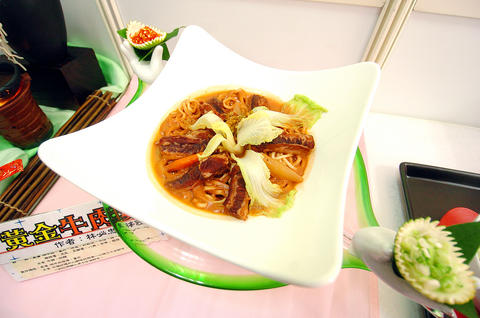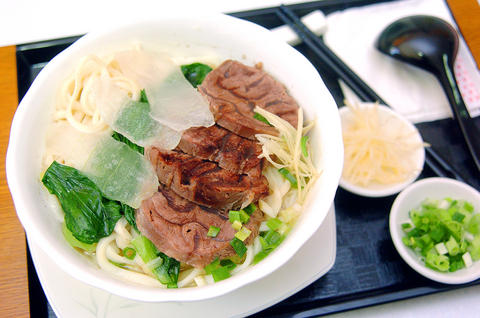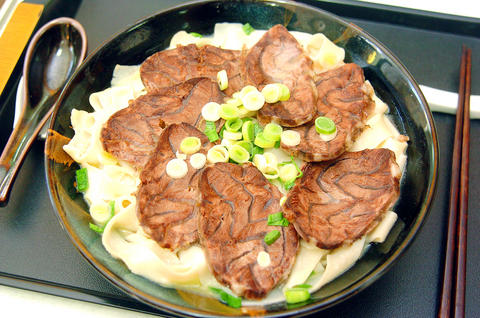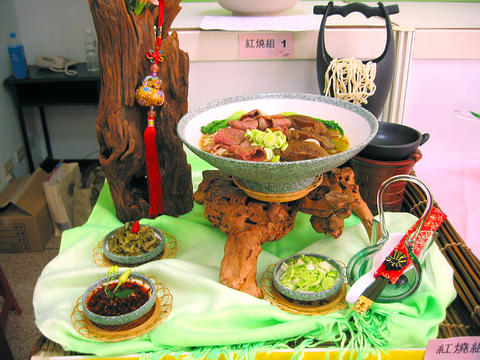In Taiwan, there are beef noodle stores everywhere you look, some serving unremarkable concoctions of tough beef and limp noodles, others offering dishes tender and flavored to perfection. Finding the perfect bowl is what the 2007 Taipei International Newrow Mian Festival (2007臺北國際牛肉麵節) is all about.
Last Sunday, the qualifying round pronounced five finalists in each of the three categories: traditional dark broth, light broth and creative noodles. This Sunday, the best of the best beef noodles will be announced. Victory is likely to lead to packed tables for at least a year.
On Saturday, the uniquely named International Teamwork Intercourse Competition brings in six teams of international chefs to put their own spin on Taiwan's beef noodles Saturday. This event and the local competition finals on Sunday will be held at the Xinyi International Club (信義公民會館). Over the weekend, there will be a variety of performances and about 20 beef noodle stalls, so the public can appreciate all styles and flavors of the dish.

In announcing the finalists last Sunday, Cheng Yan-chi (鄭衍基), the chief judge who presided over the 45 bowls of beef noodles under consideration, pointed out that a primary consideration in assessing a bowl of beef noodles was the balance between broth, noodles and meat. Cheng, once chef to former presidents Chiang Ching-kuo (蔣經國) and Lee Teng-hui (李登輝), praised competitors' efforts, and underlined the complexity of achieving that elusive balance. "A bowl of noodles that costs NT$800 to make will obviously taste different from one that sells for NT$80 in the shop," he said.
An event like this can do no more that point customers in the right direction, and for this coming weekend, it will provide a convenient opportunity for the noodle lovers in Taiwan to indulge.
Event notes

What: Taipei International Newrow Mian Festival
(2007臺北國際牛肉麵節)
When: Saturday from 3pm to 6pm; Sunday from 9am to 2pm

Where: Xinyi International Club (信義公民會館),
50 Songqin Rd, Taipei (台北市松勤街50號)
On the Net: www.new-rowmian.com.tw/en/index.html




Exceptions to the rule are sometimes revealing. For a brief few years, there was an emerging ideological split between the Democratic Progressive Party (DPP) and Chinese Nationalist Party (KMT) that appeared to be pushing the DPP in a direction that would be considered more liberal, and the KMT more conservative. In the previous column, “The KMT-DPP’s bureaucrat-led developmental state” (Dec. 11, page 12), we examined how Taiwan’s democratic system developed, and how both the two main parties largely accepted a similar consensus on how Taiwan should be run domestically and did not split along the left-right lines more familiar in

As I finally slid into the warm embrace of the hot, clifftop pool, it was a serene moment of reflection. The sound of the river reflected off the cave walls, the white of our camping lights reflected off the dark, shimmering surface of the water, and I reflected on how fortunate I was to be here. After all, the beautiful walk through narrow canyons that had brought us here had been inaccessible for five years — and will be again soon. The day had started at the Huisun Forest Area (惠蓀林場), at the end of Nantou County Route 80, north and east

Specialty sandwiches loaded with the contents of an entire charcuterie board, overflowing with sauces, creams and all manner of creative add-ons, is perhaps one of the biggest global food trends of this year. From London to New York, lines form down the block for mortadella, burrata, pistachio and more stuffed between slices of fresh sourdough, rye or focaccia. To try the trend in Taipei, Munchies Mafia is for sure the spot — could this be the best sandwich in town? Carlos from Spain and Sergio from Mexico opened this spot just seven months ago. The two met working in the

This month the government ordered a one-year block of Xiaohongshu (小紅書) or Rednote, a Chinese social media platform with more than 3 million users in Taiwan. The government pointed to widespread fraud activity on the platform, along with cybersecurity failures. Officials said that they had reached out to the company and asked it to change. However, they received no response. The pro-China parties, the Chinese Nationalist Party (KMT) and Taiwan People’s Party (TPP), immediately swung into action, denouncing the ban as an attack on free speech. This “free speech” claim was then echoed by the People’s Republic of China (PRC),